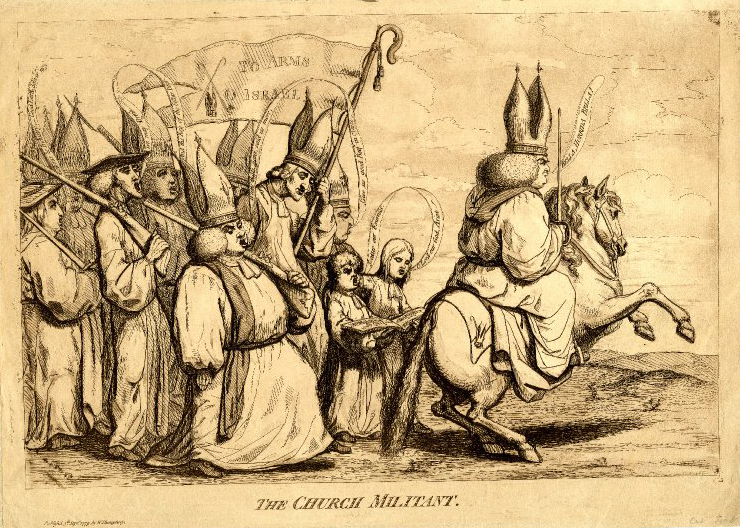The Church Militant
As the son of a Moravian Sexton, Gillray would no doubt have been familiar with the idea of a "church militant" consisting of all the Christians on earth in a perpetual struggle with sin and the devil.

© Trustees of the British Museum
The church militants in this print, however, are largely restricted to the upper echelons of the church hierarchy and the struggle is anything but spiritual. The leader of the group holds a sword and is mounted on a rearing charger reminiscent of images of kings and war heroes. His followers hold muskets and banners.
According to Wright and Evans, this clerical/military procession is led by William Markham, the Archbishop of York, and also includes the Archbishops of Canterbury and Oxford. All were staunch supporters of the Lord North's policies in America. This holy war, then, is not against the devil but the colonies.
And though the first words of the choir boys are reproduced from the second verse of the British national anthem:
O Lord our God arise,
Scatter her enemies,
the real motive for their opposition, Gillray suggests, is not patriotic but self-serving—the preservation of a status quo that treats Church leaders quite handsomely. The British flag is nowhere in evidence and the insignias on the banner and the horse feature not the British crown or the Union Jack but mitres and croziers. The two fat bishops on either side of the banner sing:
Give us good beef in store
And when that's gone send us more
while two more clerics conclude with
And the key of the cellar door
That we may drink.
The satire on Anglican church leaders is exactly what one would expect from a dissenter like Gillray. But it is carried on mainly through text bubbles that are difficult to read even at full size. Gillray would do much better as he developed his craft.
Sources and Reading
- Commentary on The Church Militant from the British Museum
- Draper Hill, Fashionable Contrasts, 1966, #1
- Thomas Wright and R.H. Evans, Historical and Descriptive Account of the Caricatures of James Gillray, 1851, #5
Comments & Corrections
NOTE: Comments and/or corrections are always appreciated. To make that easier, I have included a form below that you can use. I promise never to share any of the info provided without your express permission.